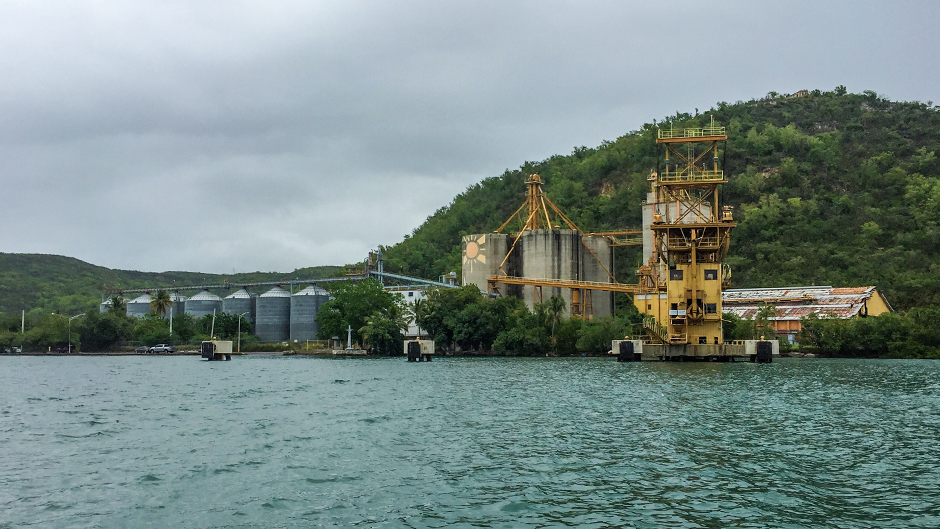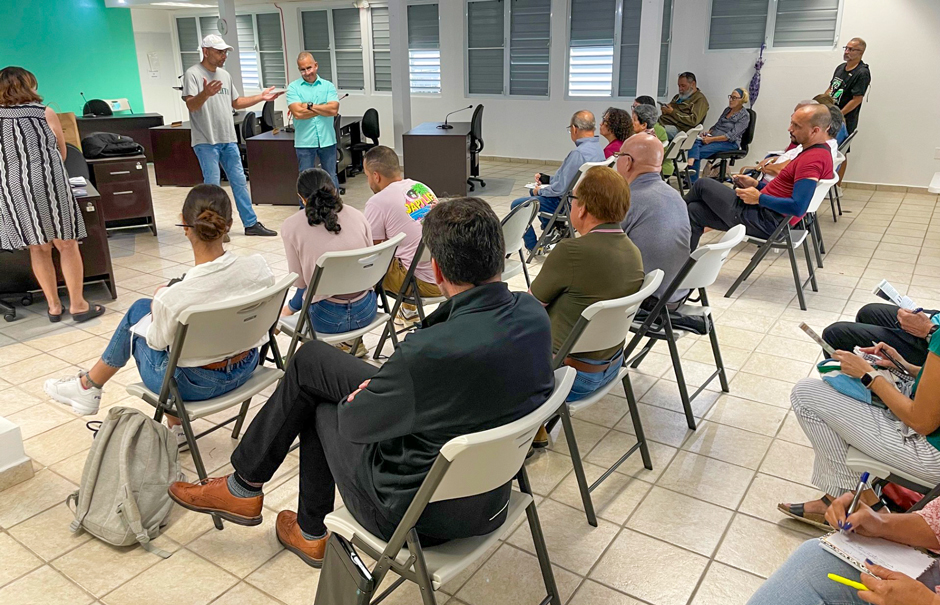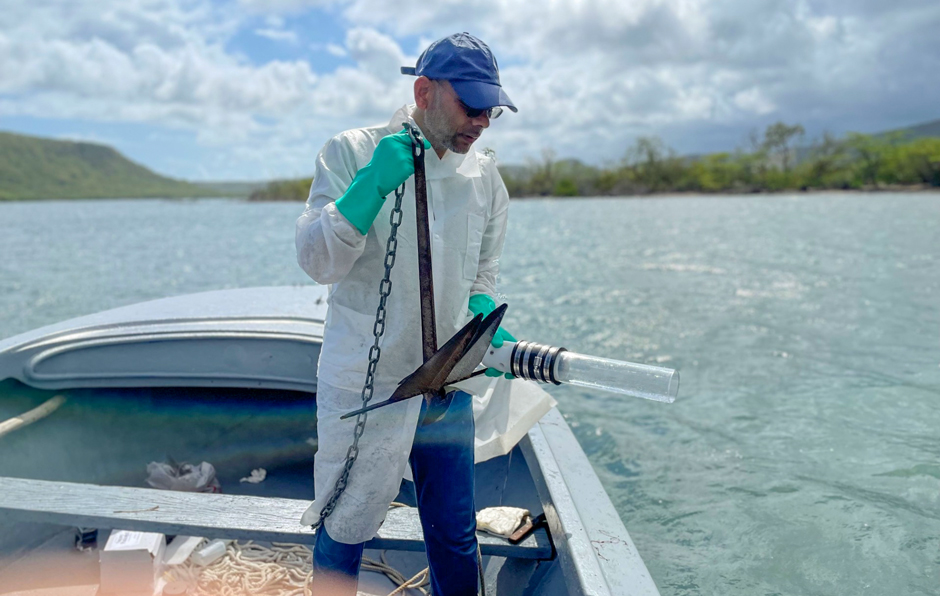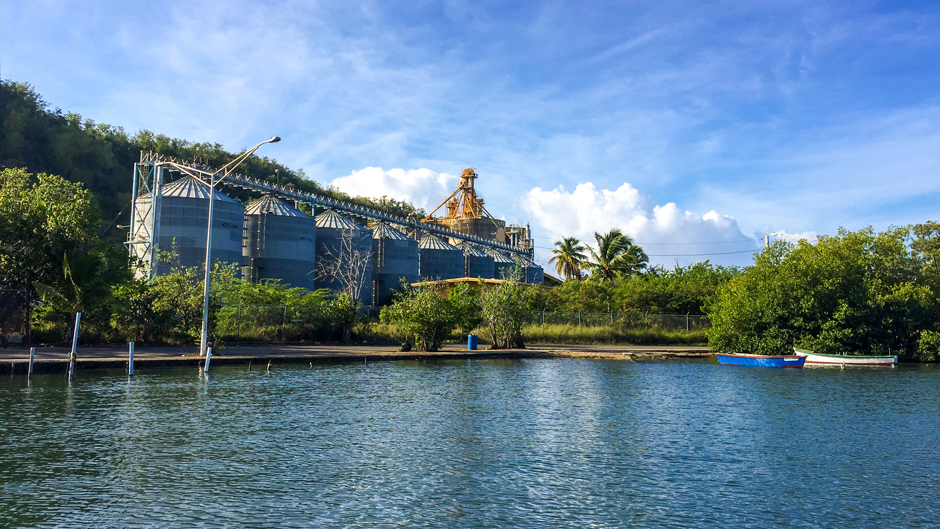The view from the front porch of Ada Vélez’s Guánica, Puerto Rico, home is the same as it was decades ago when she was a little girl.
“I can still see the giant silos of the old fertilizer factory that sits across the bay,” said Vélez, 69, who has lived in her family’s one-story house on Julio Street for her entire life.
“One summer day, when my oldest brother was home on break from college, he went to work at that factory,” she recalled. “On his first day there, he came home covered in black soot. My mom gave him some soap and towels and said to him, ‘You’re not coming into this house like that. Wash yourself and throw your clothes in the trash can. And you’re not going back to that factory.’”
Today, only remnants of the old Ochoa Fertilizer factory remain. But the plant, as well as a now-shuttered chemical manufacturing company and former electrical substation, left something behind that has posed a threat to the health of a small group of Guánica residents like Vélez for decades.

Elevated levels of polychlorinated biphenyls (PCBs), a class of human-made “forever chemicals” so toxic that Congress banned them 45 years ago, now saturate the soil of several commercial and residential properties in Guánica as well as the sediment of Guánica Bay.
“It’s an alarmingly high concentration of PCBs—in fact, the second highest levels of PCBs ever recorded in sediment anywhere in the U.S.,” said Naresh Kumar, a professor of environmental health at the University of Miami Miller School of Medicine, who, more than 10 years ago, began measuring levels of the dangerous chemical in different environmental settings in Guánica. “They’ve remained persistent in the environment, becoming aerosolized and even showing up in fish caught from the bay.”
Before their manufacture was banned in 1979, PCBs were used widely in electrical equipment such as transformers and fluorescent light ballasts.
Extensive testing
Kumar, who along with a team of researchers from the University and elsewhere published a study on the health implications of PCBs in Guánica, has traveled to the town of more than 13,000 in southern Puerto Rico on numerous occasions over the past few years, conducting extensive tests of the soil and organizing town hall meetings with residents to help educate them on the dangers of being exposed to PCBs.

He began testing for the chemicals in Guánica’s sediment after learning about previous research conducted by the National Oceanic and Atmospheric Administration (NOAA) that revealed elevated concentrations of PCBs in the bay.
“We extensively sampled the bay to see if pollution in the marine environment was making its way to the offshore coral reefs in Guánica Bay, and that’s when we discovered that really big hotspot of PCBs over by the Ochoa site,” recalled David Whitall, senior principal investigator at NOAA’s National Centers for Coastal Ocean Science.
Kumar and his team quickly got involved, traveling to Guánica as part of their efforts to address the health impacts of PCBs. They not only recorded high levels of the chemical in soil but also elevated levels of heavy metals, organochlorine pesticides, and polycyclic aromatic hydrocarbons.

The researchers also discovered high levels of PCBs in fish caught from the bay. But it was blood samples taken from 150 Guánica residents that alarmed Kumar the most. Eighty-six percent of those samples contained levels of PCBs.
Superfund designation
Ever since Kumar began his research in Guánica, it has been the researcher’s goal to have the Ochoa site placed on the Environmental Protection Agency’s Superfund list, which includes hundreds of abandoned mines, shuttered factories, radioactive landfills, and other contaminated areas across the U.S. Officially called the Comprehensive Environmental Response, Compensation, and Liability Act, but informally known as Superfund, the act allows the EPA to clean up contaminated sites and also forces polluters to either perform cleanups or reimburse the government for EPA-led cleanup efforts.
In September 2022 the location was added to the Superfund list, and last year, in March 2023, Kumar and dozens of Guánica residents got the news they had long hoped for. The EPA announced that it had reached an agreement with the Guanica-Caribe Land Development Corporation to remove soil contaminated with PCBs from 19 residential and commercial properties in Guánica.
Cleanup efforts got underway on June 10, and the EPA anticipates that excavation at those 19 properties will be completed in October, according to Guillermo Hernandez-Lopez, remedial project manager for the EPA’s Caribbean Environmental Protection Division in Guaynabo, Puerto Rico.
Still, some Guánica residents have expressed concerns that the cleanup effort is not extensive enough.
“Out of the multitude of houses that are in the vicinity of the bay and in the vicinity of what used to be a chemical manufacturing plant, I find it hard to believe that only 19 properties have been identified as units that warranted cleanup,” said Edgardo Cruz, a retired U.S. Air Force lieutenant colonel who was born in Guánica and still lives there in the house where he was raised.
“My neighbor’s house across the street has been designated as needing to be cleaned up, but not my residence. And I live only 30 feet away from her,” Cruz said.
Hernandez-Lopez pointed out that the cleanup effort is being conducted at properties with contaminated soil that exceeds the EPA risk-based level of 1 milligram per kilogram. “Under the removal order, the Guanica-Caribe Land Development Corporation is also evaluating properties located near the 19 properties [designated for cleanup],” he said in a statement. “Several of these properties have already been identified as exceeding the 1 milligram per kilogram level of PCBs, and these will be excavated as part of the removal action.”
While the current cleanup is a short-term response to address immediate threats, the EPA is in negotiations with Guanica-Caribe and three other potentially responsible parties to conduct a feasibility study at the site that will evaluate permanent solutions for areas found to be contaminated with PCBs and other hazardous substances, according to Hernandez-Lopez.
Health impacts
Kumar’s work measuring and recording dangerously high levels of chemicals in Guánica’s sediment and air continues. He recently traveled to the town to deploy more air samplers on the roofs of homes and to distribute flyers in Spanish and English that inform residents about the dangers of PCBs and heavy metals, and the steps they can take to protect themselves.
Cruz hopes to work with Kumar in partnering with medical schools in Puerto Rico to test more blood samples from Guánica residents. They are concerned about serious illnesses some residents may have contracted because of longtime exposure to contaminants detected in the Ochoa Superfund site.
Vélez believes the different forms of cancer that have taken the lives of many of her family members can be linked to the site. “It could be related, or it could just be bad luck. But my mom, my grandfather, a cousin, and an aunt all had and died of cancer, and they lived in Guánica all their lives,” she said.
“We’re a community that’s been rocked by hurricanes, an earthquake, and even an oil spill in our bay,” Cruz said. “We’re one of the poorest towns in Puerto Rico, and our infrastructure is limited. If I want to buy a pair of pants or underwear, if I want to go to a supermarket different than the supermarket that we have here, then I have to travel to the next town. We don’t have a hardware store or a bank. We have only one ATM machine. But Guánica is worth fighting for.”

